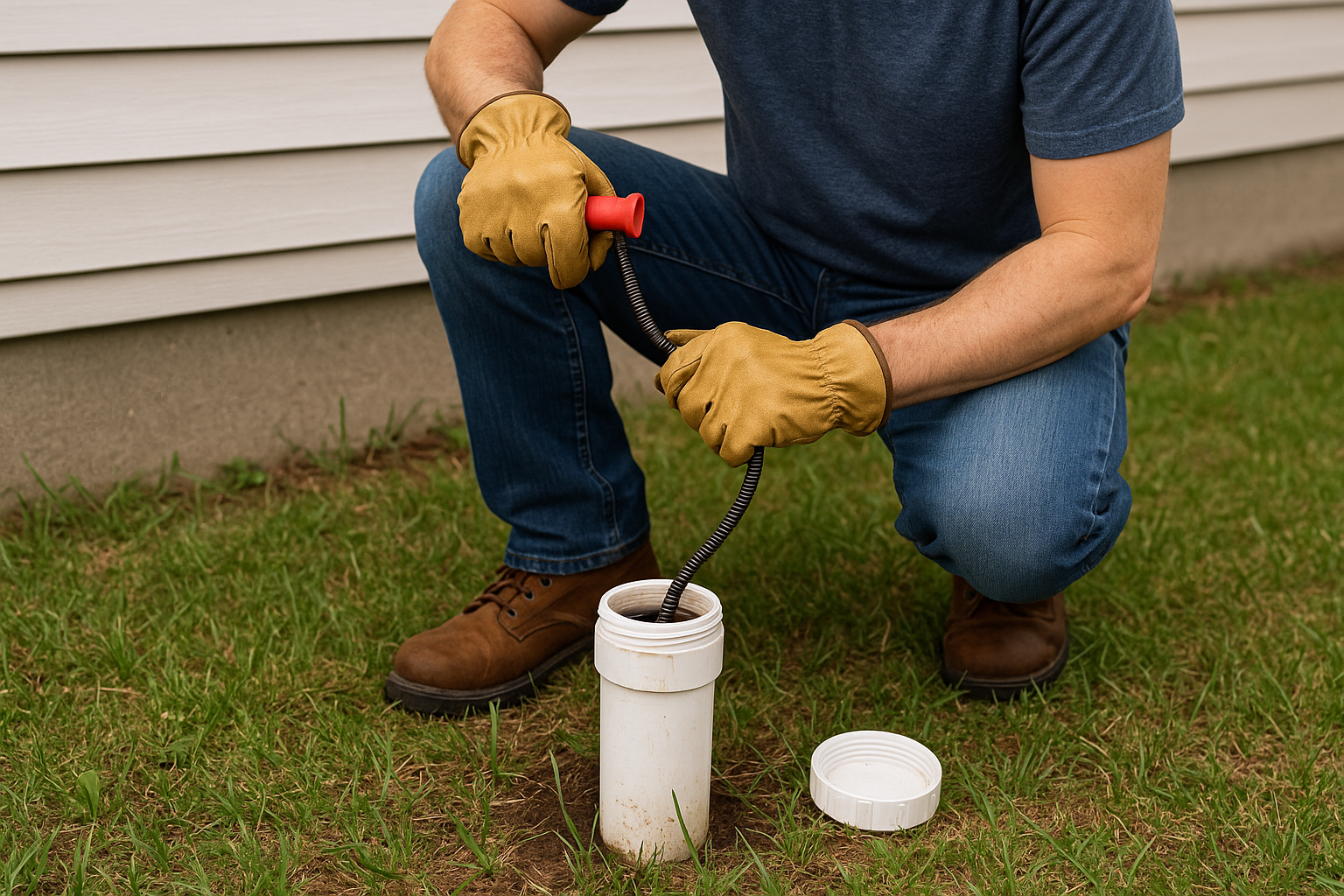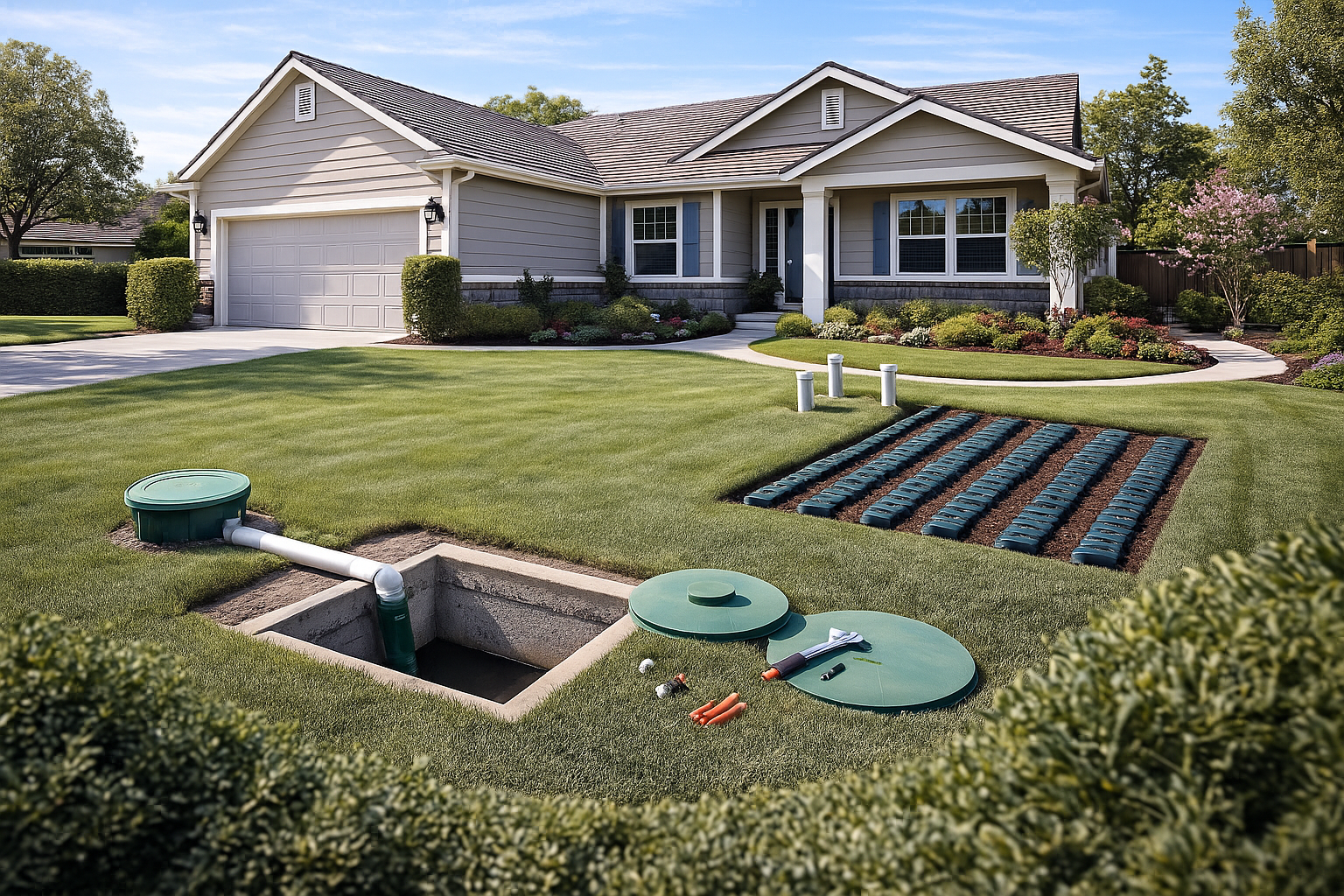Have you ever noticed your sinks draining slower than usual or your toilet making strange gurgling sounds? These small signs often point to a bigger issue: a clogged septic line. Learning how to unclog a septic pipe or clear septic blockage can save you time, money, and stress in the long run. It’s a frustrating situation that can disrupt your home routine and, if left unchecked, lead to costly repairs.
The good news is that not every clog requires an emergency call to a professional septic service or septic repair technician. With a little know-how, you can perform DIY septic maintenance safely and effectively. Using a septic line cleaner or homemade septic unclog solution can often restore proper flow and prevent further issues before they become major problems. You can also check out this guide on DIY septic system maintenance for more practical maintenance tips.
Keeping your septic line clear isn’t just about convenience — it’s about protecting your home and ensuring your entire system works efficiently. A healthy line helps prevent septic clogs, avoids unpleasant septic odor in house, and keeps messy backups from occurring.
In this guide, you’ll learn safe, practical steps on how to fix clogged septic tank problems without damaging your system. We’ll walk through simple DIY septic tank cleaning methods, tools like a septic line snake, and natural septic unclog method ideas that make the process smoother. By following these steps, you’ll feel confident knowing exactly how to clear main septic line issues safely.
Understanding Septic Lines and Why They Clog
Septic systems have been used for over a century as an effective way to treat household wastewater. Even as materials and technology improve, the purpose remains the same: moving waste safely from your home into the tank and drain field. The septic line, the pipe connecting your home’s plumbing to the tank, is the critical link that makes this process possible.
When we talk about a “septic line,” we’re referring to the underground pipe that carries wastewater into the tank. Just like traffic jams on a highway, this pipe can get blocked by grease, paper, or even tree roots over time. A severe septic pipe blockage removal or septic root removal may be required if clogs persist.
A clog here doesn’t just slow things down — it can cause a septic tank drainage problem, leading to a septic system backup fix or even a septic tank overflow fix if ignored.
Millions of households rely on septic systems today. As people grow more aware of how to maintain septic system health, there’s an increasing focus on what should or shouldn’t go down the drain. Still, clogs remain one of the most common issues. Aging systems, tree roots, or excessive water use often cause backups. Sometimes, scheduling a septic system inspection or septic tank pumping service with septic system repair near me professionals is necessary for deeper problems.
If you own a rental or secondary home, see our helpful guides on septic care tips for rental property owners and vacation home septic maintenance to prevent costly issues in multiple properties.
By understanding what causes signs of septic line clog, you’ll know how to act early. From using eco friendly septic cleaner products to performing routine septic drain cleaning and septic line pressure washing, proactive care is key to preventing expensive repairs later.
Common Causes of Septic Line Clogs
Before you confidently tackle a clogged line, it’s important to know what causes it. Understanding septic backup causes helps you address problems faster and avoid repeating the same mistakes.
Here are the most common culprits:
- Grease and fats – Cooking oils harden as they cool, sticking to pipes and causing buildup.
- Non-biodegradable items – Wipes, feminine products, and paper towels don’t break down easily.
- Tree root intrusion – Roots seek moisture and can grow into the line, requiring septic root removal or even septic pipe replacement.
- Soap scum and sediment – Soap and minerals can coat pipe walls, leading to reduced flow.
- Excessive water use – Pushing too much water too quickly can overload the tank, forcing solids into the line.
Combine these issues and you’ll see how quickly a clog forms. Whether from grease buildup or tree roots, blockages can stop wastewater in its tracks. Some homeowners even confuse a clogged drain vs septic issue, leading to wasted time on the wrong fix.
For additional prevention tips, you can explore this article on whether septic enzyme treatments are worth it — a helpful resource for long-term care.
Knowing these causes means you’re better prepared to perform DIY septic maintenance, apply safe septic cleaning chemicals, or schedule help when needed.
Benefits of Tackling Septic Line Clogs Yourself
Taking time to learn how to fix clogged septic tank issues yourself comes with more advantages than you might expect. Not only does it save money, but it also gives you control over your home’s maintenance. By using tools like a septic line snake, hydro jetting, or septic pipe flushing, you can resolve small issues before they become serious.
Here are some benefits of DIY septic tank cleaning and natural septic unclog method care:
- Cost savings – Avoid unnecessary bills from a septic repair technician for small issues.
- Immediate action – Handle problems before they grow into full septic system backup fix emergencies.
- Increased confidence – Learn how your system works and how to avoid septic backup through preventive habits.
- Preventive care – Routine septic field maintenance and septic system inspection catch early issues.
- Peace of mind – Knowing you can unclog septic pipe problems gives you control and reassurance.
When you take charge of how to maintain septic system tasks, you’re not only saving money but extending the lifespan of your setup. Whether it’s adding eco friendly septic cleaner treatments or performing septic line hydro jetting when needed, consistency is key.
Challenges of DIY Septic Line Unclogging
While DIY maintenance has many benefits, it’s important to recognize its limits. Some clogs are deep, requiring professional septic line pressure washing or septic pipe replacement.
Common challenges include:
- Hidden or severe blockages that require advanced tools
- Risk of pipe damage from using the wrong chemicals instead of safe septic cleaning chemicals
- Health and safety concerns from working with wastewater
- Temporary fixes that don’t completely clear septic blockage
- Time and effort for stubborn clogs or large systems
The solution? Use septic-safe tools like a septic line snake or eco friendly septic cleaner, wear protective gear, and know when to call professional septic services or septic system repair near me experts.
If you’re dealing with odor concerns, this guide on the best septic deodorizers can help eliminate unpleasant smells effectively.
When deeper issues like septic tank drainage problem or main sewer vs septic line confusion occur, professionals can help with accurate diagnosis. If the clog persists despite your effort, a septic tank troubleshooting service may be required to assess the system thoroughly.
Step-by-Step DIY Guide to Unclogging Your Septic Line
Now that you know the causes and challenges, it’s time to take action. Here’s how to safely unclog septic pipe problems using DIY septic tank cleaning techniques:
- Identify the problem – Look for signs of septic line clog like slow drains or gurgling toilets.
- Locate the access point – Find the cleanout pipe near your home or tank.
- Gather tools – You’ll need gloves, goggles, and tools like a septic line snake or auger.
- Insert and rotate – Slowly feed the snake into the pipe to clear septic blockage and break up debris.
- Flush the system – Perform septic pipe flushing to remove residue and test water flow.
- Inspect afterward – Check for recurring problems; if it returns, consider septic line hydro jetting or calling an expert.
You can also use homemade septic unclog solution options, such as enzyme-based mixtures, or consider the best septic treatment products to keep the line clean.
The Future of Septic Line Care and Maintenance
Septic systems are becoming smarter and more sustainable. With new eco friendly septic cleaner products and advanced monitoring, caring for your system is easier than ever. Future tools may automatically alert homeowners before septic tank overflow fix situations occur.
Innovations like septic line hydro jetting, improved materials that prevent root intrusion, and preventive septic field maintenance services help systems last longer. More homeowners are also subscribing to routine septic tank pumping service schedules to stay proactive.
Professional septic services are adapting, offering preventive plans rather than just emergency septic service calls. These include septic system inspection reminders and septic line repair cost transparency, helping homeowners make informed decisions.
As awareness grows, more people now recognize that caring for their system isn’t just reactive — it’s about how to avoid septic backup and create long-term sustainability.
Bringing It All Together
We’ve explored everything from how to fix clogged septic tank issues to how to maintain septic system health long-term. The key takeaways are simple:
- Know your septic backup causes to reduce risks.
- Use tools like a septic line snake and safe cleaners instead of harsh chemicals.
- Combine DIY septic maintenance with occasional professional septic services.
- Stay consistent with septic field maintenance and septic tank pumping service routines.
Understanding your septic line isn’t just about clearing today’s clog — it’s about avoiding the next one. Regular care, such as septic pipe flushing or eco friendly septic cleaner use, ensures smooth flow and fewer emergencies.
Final Thoughts and Next Steps
Caring for your septic line may not sound exciting, but it’s one of the most rewarding parts of homeownership. Whether you’re handling a septic system backup fix, using a natural septic unclog method, or applying the best septic treatment available, these small steps add up to major results.
To stay ahead:
- Try one DIY septic maintenance habit this week.
- Schedule a septic system inspection or consult septic system repair near me professionals.
- Learn how to avoid septic backup with preventive practices.
- Use safe septic cleaning chemicals to protect your pipes.
Your efforts will pay off through clearer drains, fewer emergencies, and a system that runs efficiently for years. With consistent care — from routine septic drain cleaning to occasional septic line pressure washing — you’ll keep your home safe, clean, and running smoothly.
Here’s to a future of well-maintained systems, reliable performance, and peace of mind.






